
Brown Snake
Latin name: Storeria dekayi
Size: 5 to 15 inches
Venomous: No
The brown snake is quite a secretive snake, spending a lot of its time underground, or beneath loose leaf litter, in moist, grassy, or heavily-treed areas. The species itself is common, and residential homeowners frequently unearth it when turning over rock or tree piles in backyards. They're a common invader of residential parks, too, alongside inhabiting swamps, bogs, other bodies of freshwater, and the land surrounding.
This snake's diet means that it can survive very well underground for long periods of time: earthworms, snails, slugs, and other insects — although the 'other' is usually an accident.
Eastern Copperhead
Latin name: Agkistrodon contortrix
Size: 20 to 40 inches
Venomous: Yes
The northern copperhead dwells in habitats that are wooded, with scattered rocks, and with plenty of debris for ground coverage, such as fallen leaves. Their coloring works as great camouflage against this backdrop, usually an orange, red-pink, or rust-copper shade, decorated with darker patches of color that look a little bit like an hourglass shape. The coloring can be similar to that of the non-venomous milk snake.
Although this snake will warn before it bites, it does have the title of being the snake to bite the most people in the United States. Thankfully, the venom very rarely causes fatalities, but the bite itself is said to be a very painful affair that is definitely best avoided.
Eastern Smooth Earth Snake
Latin name: Virginia valeriae valeriae
Size: 7 to 10 inches
Venomous: No
The smooth earth snake can be found in the most southern areas of Ohio, in heavily-treed spaces, such as the state forests of Pike. Unlike the northern subspecies of smooth earth snake, the eastern variety has a wider, plumper body and is usually missing the markings along the back. The scales on the back are commonly decorated with little black dots, and the neck and head area is much smaller and less defined than in other species.
Eastern Fox Snake
Latin name: Pantherophis gloydi
Size: 4 to 8 inches
Venomous: No
Despite being confused regularly for a rattlesnake, black rat snake, or copperhead, the eastern fox snake is a relatively harmless species of snake that will send out plenty of warning signs before it strikes — which is why bites are quite rare. As well as rattlesnake-like shaking tail that helps to scare off predators, this species of rat snake also coils up and makes itself appear intimidating before eventually snapping.
They are diurnal, meaning that they are active during the day and sleep at night, and they are also quite solitary snakes.
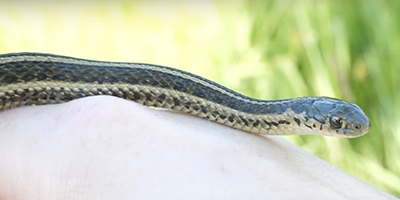 Butler's Garter Snake
Butler's Garter Snake
Latin name: Thamnophis butleri
Size: 14 to 30 inches
Venomous: No (Yes, but it doesn’t affect humans)
It is believed that the colonies of Butler’s garter snake in Ohio are isolated colonies, much more suited to open, flat, dry fields, but they can still be spotted in the north-westerly region of the state. You might miss it if you do happen to come close to this subspecies of garter snake, however; it is small, slender, and has a smaller head than other garter snakes, although the orange-yellow stripes running down the body are certainly bright enough to stand out in some cases.
As well as being different in appearance to other types of garter snake, the Butler’s subspecies likes to put on a bit of a display when threatened, choosing to thrash and smash itself about rather than immediately fleeing the scene.
Eastern Garter Snake
Latin name: Thamnophis sirtalis sirtalis
Size: 18 to 26 inches
Venomous: No
Commonly called garden snakes, repeatedly confused with ribbon snakes, but a distant cousin of the water snake, the eastern garter snake is found in almost all types of wetlands across Ohio, including streams, moist meadows, marshes, bogs, rivers, drainage ditches, and wet woodlands.
This snake has been given its name because of the stripes down the back of the body; they resemble garter straps that were once worn to keep socks up. It comes in a range of colors, often brown, with lighter stripes, but in some areas the snake can look almost completely black.
Plains Garter Snake
Latin name: Thamnophis radix
Size: 18 to 26 inches
Venomous: No
This snake is endangered in the state of Ohio, and was added to the list back in the seventies, but in the last 20 years, Columbus Zoo has corroborated with other local animal organizations to release more than three hundred captive-bred individuals back into the wild, in a bid to boost numbers again. These snakes have all been given a microchip to ensure conservation success, so if you happen to spot one in the state, there is a chance it could be one of these.
Short-Headed Garter Snake
Latin name: Thamnophis brachystoma
Size: 10 to 22 inches
Venomous: No
The short-head garter snake is usually found in Pennsylvania and New York, but it is believed to have spilled over, or been introduced into the state of Ohio. It is found only around the border of Ohio and Pennsylvania, in the north-east part of the state. Very rarely will it be out in the open, instead preferring to stick to the protection that branches, logs, boulders and rocks can offer along the ground.
Although slow to bite, this snake will if provoked enough, but it primarily relies on defense techniques to escape from humans and other predators. This includes expelling a fluid that smells unpleasantly musky, plus excrement.
Rough Green Snake
Latin name: Opheodrys aestivus
Size: 20 to 46 inches
Venomous: No
This snake is every bit as green as the name would lead you to believe, although the underside is normally closer to yellow than green, much lighter than the top of the body. The rough green snake is found in only the very southern counties of the state of Ohio, where it lives in marshy grasslands, roadside ditches, in areas of blackberry and other, similar bushes, and in meadows, often moist and close to water. They feast on various insects that it finds in abundance, helping to keep populations in check — caterpillars, ants, grasshoppers, spiders, butterflies, moths, and crickets.
Smooth Green Snake
Latin name: Opheodrys vernalis
Size: 10 to 20 inches
Venomous: No
You might find this fast, shy snake species in a host of different habitats, but they all tend to be close to a body of water — close to lakes, rivers or streams; wide-open forests or woods; in marshes and meadows; and also in other areas where long grass is left to grow. The snake uses this, along with its bright green colouration, to camouflage as it moves around during both the day and night. Warmer weather often means more daytime activity, with colder temperatures forcing the snake to retreat to mouse or rat burrows, or even ant hills to hibernate. Although solitary, multiple adults can come together during the winter, to share a burrow.
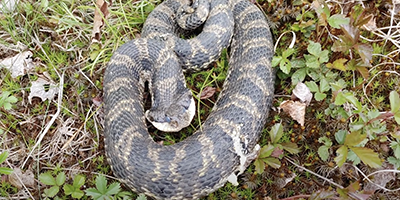 Eastern Hog-Nosed Snake
Eastern Hog-Nosed Snake
Latin name: Heterodon platirhinos
Size: 15 to 42 inches
Venomous: No (Yes, but it doesn't affect humans)
The variations of color and markings of this snake make it hard to distinguish from other species, but the nose gives the game away. As the name would suggest, the snout of this snake looks very hog-like, upturned at the end, and a great tool for burrowing around beneath the surface of the ground.
Also known as the deaf or spreading adder, because of the way it puffs up the face and neck when threatened, this snake is not actually as scary as it looks. It rarely bites, although they certainly make it look like they are about to, lashing forward and mimicking the biting action, but without making real contact.
Eastern Black King Snake
Latin name: Lampropeltis getula nigra
Size: 30 to 60 inches
Venomous: No
Ohio is home to a relatively small population of this snake species, one that is often confused with other species, including the black racer and black rat snake. It is only in the spring and early summer that you may encounter this snake out in the wild, basking, but it is thought to be rare in the state. At this point, it seems to be only present in a few select areas, including the bottomlands of Ohio River, and the counties of Jackson, Lawrence, Scioto, and Adams.
Kirtland's Snake
Latin name: Clonophis kirtlandii
Size: 12 to 18 inches
Venomous: No
This snake is very rare, threatened species in the state of Ohio, a water snake that spends less time in the water than other types of water snake. It commonly inhabits marshes, swamps, wetlands, moist grasslands, and moist forests, and over recent years, appears to have been drawn to the edges of big cities and towns.
The scales of this snake are usually gray in color, with three lines of uneven spots running down the length of its body: one in the centre, plus one running down each side. The underbelly of this species also has uneven dots or splotches, although they are against a much paler backdrop, tinged slightly red.
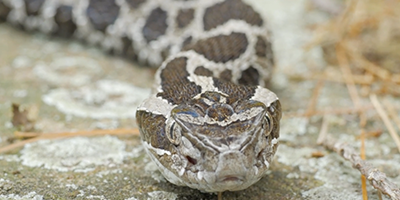 Eastern Massasauga
Eastern Massasauga
Latin name: Sistrurus catenatus
Size: 24 to 30 inches
Venomous: Yes
The eastern massasauga snake can be found in many areas across central and northern Ohio, in temperate bogs, swamps, and marshes, as well as surrounding forests and woodlands. They seem to prefer lower, damp regions, but have a tendency to move to uplands and other dry spaces during the warmer months of the year.
Although a venomous pit viper, this snake is quite lazy, very solitary, and is more active during the day. They’re also a hibernating species, often returning to the same places to hibernate each winter, and not straying far from the range they class as ‘home’.
Eastern Milk Snake
Latin name: Lampropeltis triangulum
Size: 24 to 52 inches
Venomous: No
Also known as the scarlet king snake, the eastern milk snake is a slender, brightly-colored snake that comes in a wide range of colours and patterns. Generally, the snake is a lighter color (tan/light brown/gray), decorated with patches of a much brighter color (orange/red/rust-brown), bordered with a darker color (dark brown or black).
Once categorized as a milk snake, but now commonly known as a king snake, the milky name refers to an old myth that told of these snakes sneaking into barns and literally sucking cows dry of their milk stores. This has since been disproved, but the name has stuck around.
Queen Snake
Latin name: Regina septemvittata
Size: 13 to 30 inches
Venomous: No
This semi-aquatic, non-venomous snake is also known by a number of other names, such as three-striped water snake, pale snake, leather snake, and many others. It prefers substrates that are rocky, and waters that are fresh, and the number one source of food on the menu is juvenile crayfish. (Adult crayfish have painful pincers!)
A usually non-aggressive snake that rarely bites, you run the risk of being covered in a musky, foul-smelling fluid if you attempt to handle a queen snake. This is one of their defense mechanisms, but it will usually flee before it lets you get that close, often into water where it soon disappears.
Blue Racer
Latin name: Coluber constrictor foxii
Size: 35 to 75 inches
Venomous: No
You may encounter a blue racer along the western borders of the state of Ohio, a snake that has been given its name because of the speed at which it slithers away from predators or conflict, including humans. When compared to other snakes, it moves at some speed. In reality, it actually only moves at 4mph — but that’s still pretty fast!
These snakes are quite aggressive when disturbed. They will usually shake their tail and put out other warning signs before biting, but they will not hesitate to bite if they feel it is their only option. Because they rely on sight more than other snake species, the racer will turn straight to look at prey or potential threats, which can seem quite intimidating.
Black Racer
Latin name: Coluber constrictor constrictor
Size: 35 to 75 inches
Venomous: No
You may find the black racer along the eastern borders of the state of Ohio, where the snake is also known as the northern black racer as well as a few other names. Given its black name because of the entirely black scales it usually boasts, it actually doesn't chase after humans to attack them despite what you may have read on the internet. This non-venomous snake will bite - multiple times - if it is under threat and has no other option, but it will hiss loudly, as well as shaking its faux-rattle tail before doing that.
Eastern Rat Snake
Latin name: Pantherophis obsoletus
Size: 42 to 72 inches
Venomous: No
The eastern rat snake, also sometimes known as the black rat snake, is the longest snake you’re likely to encounter in the state of Ohio. Despite being quite intimidating-looking snakes, they are harmless to humans, although will bite if provoked. They are non-venomous, would rather retreat than fight, and will clean up rat and mouse populations. This snake generally will not live in an area where rodents aren't present.
With the exception of a light cream or white chin, this snake is almost entirely black, earning it the names black rat snake, black snake, and pilot black snake.
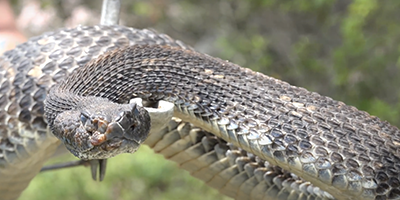 Timber Rattlesnake
Timber Rattlesnake
Latin name: Crotalus horridus
Size: 36 to 60 inches
Venomous: Yes
The timber rattlesnake is known by a host of other names, including banded rattlesnake and canebrake rattlesnake, and comes in a wide range of colours and variations. Usually, the body is a gray, brown, or yellow-brown, decorated with a cross-band pattern that is either black or very dark brown, perfect camouflage in the backdrop of swamps, rivers, hilly woodlands, and long grasslands it is known to inhabit.
Although a dangerous and venomous snake, with a high venom yield, bites are rare and fatalities are even rarer. This snake is rarely sighted, and populations are on the decline. In many states, they are protected and considered a threatened species.
Northern Red-Bellied Snake
Latin name: Storeria occipitomaculata occipitomaculata
Size: 8 to 10 inches
Venomous: No
This is one of the smallest snake species found in Ohio, but the northern red-bellied snake can come in names other than what its name would suggest. Usually, it has a body that is brown or tan, with colored patches right behind the neck and bright red or orange-red belly. Ohio has seen all-black northern red-bellied snakes, however (still with the red belly), and some of the brown-colored snakes also appear to have a somewhat purple tinge to them.
Northern Ribbon Snake
Latin name: Thamnophis sauritus septentrionalis
Size: 18 to 26 inches
Venomous: No
This snake species is likely to inhabit the very northernmost regions of Ohio, in wet or moist places, such as the edges of bodies of water (streams, lakes, ponds, etc.), open fields and grasslands, moist meadows, swamps, and marshes. This is where they chase or stalk prey items — small fish, frogs, toads, tadpoles, salamanders, and just occasionally earthworms.
Each of the different species of ribbon snake look a little different, and the northern ribbon snake specifically has three lines running down the length of its body — one down the back, two down the sides. The lines are creamy-yellow in color, but the main bulk of the snake (minus underbelly) is a very dark shade of brown or gray/black.
Ring-Necked Snake
Latin name: Diadophis punctatus
Size: 10 to 18 inches
Venomous: No
You will find the ring-necked snake across almost all of the state of Ohio, apart from a few small and select areas. These are the counties in the very north-west of the state, and also a few in the west-central part. The southern and southeastern counties offer the perfect habitat for this species: hills, rocky ledges, and plenty of woodlands.
The ring-necked snake rarely comes out of its hiding places during the day, and its hiding places usually consist of boulders, fallen trees, branches and logs, piles of leaf and vegetative litter and rocks.
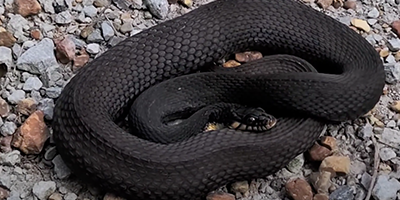 Copper-Bellied Water Snake
Copper-Bellied Water Snake
Latin name: Nerodia erythrogaster neglecta
Size: 24 to 42 inches
Venomous: No
The copper-bellied water snake, as the name makes it sound, is a water snake that has a copper-red colored belly. It can actually be a range of shades from orange through red into pink, set against a very dark brown or black color along the top. You will more commonly find this snake in the Williams County area of the state, and it is often confused for the venomous cottonmouth snake. The copper-bellied water snake is not harmless, however. It is more likely to flee when it sees you coming, and although it might bite eventually, with constant and continued provocation, it will definitely deliver some warning shots and signs first.
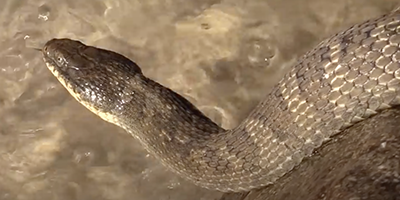 Lake Erie Water Snake
Lake Erie Water Snake
Latin name: Nerodia sipedon insularum
Size: 24 to 42 inches
Venomous: No
Found in the region of Lake Erie (as the name implies) is the Lake Erie water snake, a brown, green or gray-colored snake that has faded darker patches running along the back. The underside of the snake is a paler color, usually either a very light yellow shade, or white, with a red-pink shadow running down the middle.
Like other water snakes, this one can be found either in the water or around the edges, not normally straying too far. It was once on the endangered species list, but human conservation efforts have reversed the process and populations are back to a ‘safe' level.
Midland Water Snake
Latin name: Nerodia sipedon pleuralis
Size: 22 to 40 inches
Venomous: No
The midland water snake is more commonly known as the common water snake in the state of Ohio, and it can usually be found in areas close to water, such as streams and rivers with shallow depths and sand-covered bottoms. This is where people often believe it to be a venomous cottonmouth snake, but the water snake has a more slender body, and the neck is less pronounced.
This snake feeds on prey items it finds in and around the water, including lizards, crayfish, salamanders, small fish, leeches, worms, frogs, and many more. On land, they will even eat small mammals, including rodents, and birds.
Plain-Bellied Water Snake
Latin name: Nerodia erythrogaster alta
Size: 24 to 40 inches
Venomous: No
This snake can be a wide range of colours, including black, gray, green-gray, brown, olive-brown, or green, occasionally with darker (faded) patches, and with an underside that can be yellow, orange, red, or cream, usually unmarked — hence the plain-bellied name.
This water snake is rarely found far from a body of water, and less so than other types of water snake. Ponds, lakes, rivers, floodplains and all other types of wetlands in Ohio make a great home for the species, but here it falls prey to many predators, including king snakes, venomous cottonmouth snakes, and various birds of prey.
Eastern Worm Snake
Latin name: Carphophis amoenus amoenus
Size: 7 to 11 inches
Venomous: No
You may find the eastern worm snake in the southernmost counties of Ohio, just one of two subspecies that you will find in the state. It has been given the worm snake name for a number of reasons — the snake looks like an earthworm, it feeds on earthworms, and it spends a lot of time underground, especially in hot weather, on the hunt for moist soil ... just like an earthworm.
Found in farmland that sits around the edges of woodlands, and also on hillside woodlands, you’ll commonly find the worm snake in close proximity to a body of water.